Chapter 10
Including Cardio Training
IN THIS CHAPTER
![]() Undertaking a variety of types of cardio training, including intervals
Undertaking a variety of types of cardio training, including intervals
![]() Walking, jogging, or running for fitness — whichever is right for you
Walking, jogging, or running for fitness — whichever is right for you
![]() Working out indoors or outdoors on training machines, on your bike, or at the pool
Working out indoors or outdoors on training machines, on your bike, or at the pool
![]() Perusing some easy cardio training exercises you can do at home or work
Perusing some easy cardio training exercises you can do at home or work
Not all types of cardio, or aerobic, training are equal, and most can be done at varying intensities. Some people like to walk or jog, while others can benefit from working out on indoor cardio training machines, such as elliptical striders, rowers, cross-trainers, and more. You may not have access to all these machines, and some you may like to do more than others.
If you have some training machines in your house already that are dusty and holding up your clothes, it’s time to dust them off and put them back into service to boost your health and fitness. If you have access to a pool and want to swim or participate in other aquatic activities, now is the time to get started on those. For some, cycling outdoors is the way to go — fresh air, sunshine, and exercise to boot. There’s usually no wrong way to increase your endurance and overall fitness with regular cardio training.
Getting Started with Cardio Training
Though any activity that uses your large muscle groups in a rhythmic way over a period of two minutes or more is considered aerobic, feel free to pick the activities that best suit you. What works for you now may need to be shifted to another activity or a variety of training as time passes.
Considering which activities you should do
Any activity that you do continuously for two minutes or more is primarily cardio training, although some are a mixture of aerobic and more intense anaerobic activities when they involve a lot of stop-and-start movements (like tennis and basketball). Some examples of mostly aerobic activities include walking, jogging or running, cycling, rowing, swimming, arm biking, aerobic exercise classes, aerobic machines such as the elliptical trainer, recumbent or cross-trainer bike, conditioning machines, circuit training, and dancing.
Looking at amount, intensity, and duration
To follow the latest guidelines (including those in Chapter 9), all healthy adults who are 18 to 65 years old should do at least 150 minutes of moderate cardio training or 75 minutes of vigorous exercise per week (or a combination of both). This recommendation also applies to all adults with type 1 or type 2 diabetes.
Because most people with type 2 diabetes have a low aerobic capacity, doing 150 minutes of moderate (or harder) cardio training each week is particularly beneficial. If this scenario describes you, focus on getting in enough exercise to get fit, with the added benefit of possibly burning some extra calories to help you lose weight or keep your weight down.
Decoding the difference between moderate and vigorous
Moderate-intensity activities make you feel like you’re working “somewhat hard,” but you should be able to talk while exercising (but not sing). Examples of moderate exercises include brisk walking, swimming laps at a steady pace (but not pushing too hard or sprinting), and cycling on level terrain. Take advantage of any strong physical attributes you have when you pick your activities. Low-impact or non-weight-bearing types of activity, such as cycling, swimming, and aquatic or chair exercises, may be more appropriate for those with complications or coexisting conditions like peripheral or autonomic neuropathy. (Head to Chapter 16 for more on exercising with diabetes and other health conditions.)
Vigorous- or high-intensity activities challenge you physically and feel “hard” due to your more rapid breathing and greatly elevated heart rate. During them you may have trouble talking due to heavy breathing. Some examples are race walking, jogging or running, water jogging, bicycling uphill, gardening with a shovel, and playing competitive sports like soccer or lacrosse. For individuals without lower-body joint limitations or other limiting health conditions, jogging and running are acceptable high-intensity activities. (Flip to the later section “Jogging or Running Indoors or Outdoors” for more on these options.) In general, two minutes of moderate-intensity activity is the equivalent of one minute of vigorous-intensity activity in terms of calories burned and fitness gained.
Breaking up exercise into shorter periods
You can break up your planned aerobic activity into smaller bouts during the day — as long as it’s a minimum of 10 minutes at a time — and achieve almost the same fitness gains as doing a longer workout. (However, even doing 5 minutes at a time to start is likely beneficial if that’s all you can do. Doing enough 15-second walks during the day to reach your aerobic exercise goal, though, would be ludicrous.) Sometimes having the option to do 10 minutes here and another 10 minutes there and having it accumulate to meet your goal for the day keeps you from skipping your planned exercise entirely when life gets in the way of your doing a longer workout.
Remembering to warm up and cool down
Easing your way into and out of the more demanding part of your workout is important. The best way to do that is to spend at least three to five minutes doing an activity at a lower intensity before ramping it up to your desired one. Do an easier activity for another three to five minutes when you’re getting ready to stop to cool down. Remember that your body clears out any lactic acid that has built up more effectively during an active cool-down compared to just resting. After cooling down can also be a good time to do some stretching since all your joints are more nimble then and it’s easier to flex your joints through their full range of motion.
Determining whether to see a doctor first
Brisk walking and other mild and moderate activities are generally safe to start on your own. But if you want to do vigorous activities and you have been sedentary, it’s recommended that you see your health care provider first just to be on the safe side.
Walking Your Way to Better Health
Brisk walking is likely the best medicine for both the prevention and treatment of type 2 diabetes and for your overall health, and it’s more sustainable as a lifelong activity than many others. Walking is a great exercise for people with type 1 diabetes as well.
Walking is the most common type of physical activity done by adults with diabetes and often the most convenient. Your self-confidence may improve after you start a walking program because you’ll likely find you are better at being active than you thought, which may lead you to additional physical activities.
Walking correctly to avoid injury
To lower your chances of developing an overuse injury from regular fitness walking, you need to adopt the proper form. Really, it’s all about lining up your body parts, standing tall, and not taking strides that are too long.
Here are some tips to walk correctly for fitness:
- Try to stand up straight, keeping your shoulders pulled back. Align your head and your neck with your spine, and tighten your abdominal muscles (or at least keep them pulled in).
- Walk heel-to-toe. Use your behind foot to push off your toes, and land on the heel of your forward foot, rolling onto your toes last.
- To use your whole foot, try to let your ankle flex and move freely from back to front during each stride.
- Don’t over-stride. If you want to walk faster, simply take more steps per minute rather than longer strides.
- To get the most help from your arms, bend both your elbows at about a right angle and use them to propel you forward by swinging them next to your sides. Swing them from your shoulders, but don’t overswing them.
- Keep your hands somewhat loose at the ends of your arms. Clenching them feels like more work and doesn’t help you walk faster.
- Don’t lean forward or backward on hills. People tend to lean forward going uphill and back going downhill, which can strain the back. Keep your posture erect and use your toes (push off them more going uphill) and knees (relax them more on the downhill portions) on hills.
- Stretch regularly, particularly your lower legs. Also do some strength training with your legs to get them stronger.
Planning out your walking routine
Walking indoors on a treadmill is fine, but studies have shown that exercising outdoors has additional emotional benefits for everyone. So if you can walk outside, try to do it at least sometimes. (Always have an indoor backup plan for when the weather isn’t conducive, though.)
Choose to do your outdoor walking either for a certain amount of time or a given distance. Having a planned route helps you mentally deal with how far you’ve gone and how far you have left to go to finish.
For your planned walks, also make sure you’re wearing proper shoes and socks if you’re going to walk more than ten minutes. Athletic shoes are best because they’re made to help cushion your lower leg joints and your feet and make you more stable on your feet. Having the right shoes also helps prevent overuse injuries. Make sure to change to a new pair before the old ones completely wear out and lose their cushioning ability. Chapter 8 has more info on choosing your footwear and other exercise garb.
You don’t have to necessarily plan for unstructured walking, especially if you take steps all day to reach your target. Just keep in mind various ways to add in extra spontaneous physical activity (which I discuss in Chapter 9), and you’ll end up taking more daily steps.
Jogging or Running Indoors or Outdoors
Running isn’t for everyone. If you have any lower leg issues that get aggravated by jogging or running, simply pick other activities that don’t bother your joints or muscles in that way.
Jogging (which is running at a slower pace) is also not the best exercise to start with if you’ve been sedentary. Start with walking first and then progress to slow jogging for short periods until you can run continuously without walking or stopping. You may not be ready to progress further for weeks or months.
If you want to start jogging or already do it regularly, make sure you progress realistically with your training and don’t overdo it. Nothing is worse than starting a running program and then getting sidelined by a nagging injury or blister.
Examining outdoor jogging versus indoor treadmills
Running on hard surfaces like concrete and asphalt can take a toll on your joints. Those surfaces aren’t designed to absorb the impact of your stride, and the force each step causes is a little different from the last due to unlevel surfaces and other changes in the terrain. Outdoor running can also come with wind resistance that makes you work harder when running into it and less hard when it’s pushing you from behind.
On the other hand, most treadmills are built with padding beneath the moving belt that softens your landing, reducing the stress on your leg joints and feet. This feature is especially good if you have knee, leg, or foot pain or are recovering from an injury.
Treadmills tend to give you a less challenging workout if you don’t vary the settings — which you can do whether you choose to jog, run, or just walk. Use incline settings to simulate going up hills. Doing so helps you use up more calories and get fit faster. You can still get overuse injuries from running on the smooth surface of a treadmill belt, though.
Perfecting your technique
Perfect running form apparently varies from person to person, but everyone should avoid certain form errors. One is hitting the ground with the back of your heel first. Some experts suggest that you should learn to run in shoes like you’d run barefoot, meaning that you land more on the front part of your heel or midfoot before rolling forward to your toes. Just thinking about how you’re landing on your feet with each stride can help you develop better form.
Every runner can improve his or her running or jogging technique. Try these additional suggestions to improve your stride and avoid injuries:
- Train by varying workouts on different days: shorter distances, interval runs, tempo (near-race pace) runs, and longer-distance training runs.
- Correct common muscle imbalances like tight hip flexors (muscles that lift the thigh up) caused by too much sitting.
- Use flexibility and muscle-strengthening exercises to improve hip joint mobility, and stretch out your calves to limber up your ankles. (Chapters 11 and 13 offer some suggestions for resistance and flexibility activities, respectively.)
Keeping your joints and feet healthy with footwear
Regardless of which types of surfaces you’re running on, you should buy running shoes that provide the right kind of cushioning and stability for your foot type at a specialty store to keep this activity from ravaging your joints. Replace your shoes every 400 to 600 miles — or sooner if they’ve worn down a lot in fewer miles than that. Having uneven bottoms and less cushioning in your shoes sets your joints up for more wear and tear. Once again, get some help with selecting the right shoe for your feet.
Speeding through a workout plan
You can benefit from alternating easier and harder days and varying the type of training you’re doing. Back in the early days, long, slow distance was all the rage, but now the running experts recommend doing faster intervals or even sprint training some days, which helps increase fitness more. (For details on working with intervals, check out the later section “Including Some Interval Training.”)
- Before you start your workouts, always warm up with a slow jog or brisk walk to get the blood flowing in your muscles and your joints more limber.
- For most people, training 8 to 30 miles is a good range; more than 30 miles may raise your chances for getting overuse injuries.
- To keep from getting injured or sick from overtraining, never increase your mileage by more than 10 to 20 percent in a single week.
- If anything hurts in your feet, shins, knees, hips, or back, take some time off from running and substitute another activity (like aquatic activities).
- Train harder or do faster intervals one day a week to boost your fitness level or prepare for a running event.
- Add in another day where you train slower but longer.
- Include at least one day a week of rest — or, barring that, one day when you substitute other physical activities in place of your usual ones.
If running or jogging are activities you enjoy and you’re motivated to do a 5-kilometer (5K), 10-kilometer (10K), or longer running race, make sure you train appropriately to avoid injuries. You can search online for many recommended workouts — such as the Couch to 5K ones — and follow their training suggestions. You should take at least two months of consistent training to be ready for even a 5K event. Plan ahead and leave plenty of time to train right for your event. For additional considerations for longer events, race to the next section.
Gearing up for a longer event
If you’re training for a prolonged event like a half or full marathon, include some longer workouts to enhance your endurance capacity. They don’t all have to be long, though. In fact, most people only do one long training run a week that’s not even the full length of their upcoming event. Increasing your exercise beyond 60 minutes doesn’t increase your endurance gains enough in most cases to justify risking an overuse or other joint injury from training longer most days of the week.
Including Some Interval Training
Interval training — or doing more intense activities even occasionally or intermittently — benefits diabetes management by giving you the greatest blood glucose and weight loss benefits from your activities. Some of the potential benefits you can gain from doing interval training include the following:
- Burns more total fat and glucose than steady-pace aerobic training
- Improves your blood glucose management
- Builds endurance and speed
- Strengthens your heart muscle
- Gets the workout over with more quickly if you’re working to a preset distance or route, which may make exercise less boring and fit into your schedule better
- Extends the calorie-burning power of muscles after workouts
To get started with any type of interval training, simply increase the intensity of your exercise for short periods of time. That may just mean picking one of the interval profiles on fitness training machines or walking faster between two mailboxes from time to time when you’re out for your daily walk.
Continue to include these short, faster intervals during your walks or other activities, and lengthen them to last 2 to 5 minutes each (or even up to 30 minutes, as done in the PUP study described in the following section). You end up more fit, feel more tired when you finish (in a good way), and likely discover that your walking speed has increased due to the extra conditioning. The same intensity principle applies to almost every kind of exercise you do, from walking to cycling to gardening.
Investigating more ways to do interval training
The options for integrating interval training into your workouts are endless, and the benefits to your health are almost limitless, assuming you respect your health limitations and don’t start on this type of training before you’re physically (and mentally) ready to take it on.
The effects of interval training have been studied in some people with type 2 diabetes. In one study, active adults with type 2 diabetes who were already walking over 10,000 steps a day began pick up the pace (PUP) training, which involved some faster-paced walking during a normal workout. They measured their usual walking speed (in steps taken per minute using a pedometer) and then began walking for 30 minutes, three times a week, at a pace that was only 10 percent higher than normal. That means if their usual pace was 90 steps per minute, they upped it to about 100. Twelve weeks of PUP training for 90 minutes a week improved how well their insulin worked and increased their fitness level without requiring them to take any extra steps.
Another way to do intervals is just to vary the way you’re doing an activity. With walking, you may alternately take longer and then shorter strides for short periods of time. This method may not be as effective in terms of aerobic fitness as doing harder training, but it may encourage you to use a wider range of motion, which can help enhance the flexibility of your joints. Adding in arm movement, such as pumping your arms in an exaggerated manner while walking, can also benefit both fitness and your upper-body flexibility.
Hitting on whether high-intensity intervals are for you
Another training fad is doing high-intensity interval training (HIIT) or the related form sprint interval training (SIT). Though popular, high-intensity interval training is an inappropriate and potentially dangerous activity to start with if you’re sedentary, especially if you’re overweight or obese. After you’ve been doing other training for a reasonable amount of time (at least three to four months), or if you’re a younger, more fit person, such training may be an appropriate choice, however.
Note, too, that HIIT isn’t necessarily as efficient as it may sound. Some studies have had people do ten 60-second intervals as near maximal as possible, with one-minute active rest periods in between. That only adds up to 10 minutes of near-maximal exercise, but it takes nearly 25 minutes to complete when you add in a warm-up, cool-down, and rest periods, so it’s not much of a time-saver. Plus, people report that intense intervals lasting 60 seconds or less are more enjoyable than ones lasting longer.
Putting Indoor Cardio Machines to Use
At first, all you could use indoors to exercise was a treadmill or a stationary cycle. Over the years, the fitness industry has come up with many different exercise training machines to keep everyone interested and engaged in working out (not to mention all the various workouts themselves, such as Pilates and kettlebell training). Try them out if you haven’t already.
Exploring elliptical machines
Elliptical trainers have some advantages over treadmills. Because your feet are in constant contact with the foot pedal of an elliptical machine, using one is less stressful on your knees, hips, and back than walking or running on a treadmill. This benefit is particularly advantageous if you’ve had to stop running due to joint issues; many people who can’t run anymore have no problem “running” on elliptical machines. It’s also a full body exercise like walking or jogging on a treadmill if you use an elliptical that has arm levers while doing your leg movements.
Another benefit of elliptical striders is that you can easily choose an interval profile to follow for your workout, which can automatically take you through short periods of higher work, followed by easier segments. Most treadmills simply allow you to change your speed and the incline on them manually. Ellipticals also let you choose which parts of your lower body to focus on working harder by changing the incline of the foot pedals to get a workout for your calves all the way up to your glutes (butt muscles).
Surveying stair-steppers and other cross-trainers
Stair-stepping machines came on the scene before most elliptical ones (see the preceding section). Their workouts can be intense for many people, though, and aren’t the best place to start out if you’re sedentary. They also can irritate your knee and hip joints if walking up stairs usually bothers you.
In recent years, some hybrid cross-trainers have combined the forward movement of ellipticals with a stair-stepping motion. You can now find cross-training machines that allow you to mimic jogging, walking, running, and climbing a staircase at multiple levels of resistance and intensity. Most also have arm levers that let you get an upper and lower body workout at the same time. Many also have various profiles you can choose to add in harder intervals of some sort. All have the same benefits of reducing lower body joint stress, which is very helpful if you already have joint issues or are carrying a lot of extra body weight.
Cycling indoors as an alternative
If you have an underused stationary bike, it’s time to clean it off and put it to good use. Otherwise, you may want to consider investing in a newer model or using one at a fitness facility. You can choose between traditional ones and others that have recumbent seats (that have a back and allow you to sit normally), which are more comfortable for many people with low-back pain or other issues. The newer stationary ones also have hill and interval profiles that you can choose to increase fitness faster.
Overall, if you’re less stable biking outdoors than you used to be, using a stationary cycle can take away any concerns you may have related to falling over on your bike or crashing while riding. Indoor cycling is also recommended if you have impaired vision. It’s an activity that doesn’t make you bear your weight, which may work better if you have some mobility issues or have arthritis in some of your lower leg joints.
Rowing to get fitter
One of the best things about using a rowing machine is that you can do a full-body exercise that doesn’t make you carry your own body weight (unlike treadmills, elliptical machines, and other cross-trainers). Cycling only works the lower body muscles. Rowing is low-impact (putting little pressure on joints) and works your legs, hips, and buttocks in the lower body and your back, shoulders, and arms in your upper body. You can adjust most rowing machines to create a harder resistance to pull against, and you can vary your workout by changing the rate at which you pull.
Cross-country skiing indoors
Cross-country skiing is well-known as one of the best exercises for increasing your endurance and overall fitness. If you’re looking for a full-body workout that is weight-bearing, then using a cross-country skiing machine may be for you. It fully engages both your legs and your arms during the skiing movement, and you don’t have to worry about snow sticking to the bottom of your skis and slowing you down. The coordination you need between the movement of your arms and your legs can be tricky to work out at first, but soon you’ll be skiing like a pro on one of these machines.
Other Activities to Get Aerobically Fit
Swimming and outdoor cycling are other popular activities and as good for getting fit as brisk walking, jogging or running, and using cardio training machines. Each activity has its own unique benefits and drawbacks, but they’re worth considering as well.
Swimming your way to better health
Swimming is good for you for so many reasons, and it’s a full-body exercise. If you’re carrying a lot of extra weight, have mobility issues, or want to exercise off your feet for any reason, swimming or other aquatic exercise in a pool is a great choice. Most aquatic classes offer a blend of cardio, resistance, and flexibility training given how your body moves through water.
One of the biggest issues people have with working out in a pool is that they have to wear a bathing suit in public (unless they have their own in their backyard). The good news is that after you’re in the water, most of your body is largely hidden by the water and not that visible to others either in the pool or out.
Another barrier to doing aquatic activities is finding a pool to use, especially year-round. Even if you have your own backyard pool, you may only have access to it during the warmer seasons. Look around your area to find out about pools in local fitness clubs, community centers, senior centers, nearby schools, or other recreation centers. Most such places with pools likely also offer classes if you prefer aquatic exercises to swimming on your own.
Biking outdoors
Cycling outdoors gives you most of the same benefits you can get from using a stationary cycle indoors (see the earlier section “Cycling indoors as an alternative”). If you love being outdoors and feel stable enough to stay upright when riding a bike, outdoor cycling may be an ideal activity for you to do. Prices and types of bicycles (road, mountain, and triathlon) vary widely so talk with a reputable bike dealer prior to purchasing a bike to make sure you get the right one for you.
Considering cycling clothing and gear
Do you need to wear skin-tight cycling shorts or buy special clothes to cycle outdoors? Honestly, you can ride a bike without any special clothing at all. Your regular clothes are fine when you’re not going far or fast on your bike.
But if you’re going to be taking longer rides or cycling outdoors during nastier weather, you’ll be a lot more comfortable in cycling clothing. It’s cut to fit better when you lean over your handlebars, allows for more natural movement overall, and wicks sweat away from your skin due to its synthetic materials. The padding in cycling shorts cushions you against the bike seat and lowers your risk of getting blisters or saddle sore during longer rides. Wearing cycling gloves also takes some stress off the palms of your hands.
Investing in cycling equipment
How much you want to invest in a road cycle is up to you; they come in all price ranges. For simple rides around the neighborhood for exercise, an inexpensive bike from the big-box store may work just fine. For more serious cycling or racing, you’re talking about a lot bigger investment.
Cycle aside, make sure to invest in a helmet that fits your head well to protect against serious head injuries if you take a tumble on your bike at some point. Having an attachable water bottle or hydration pack is also recommended to make it easier for you to stay hydrated on longer rides (over an hour).
Mapping out your cycling route
If you’re into online programs and apps, an abundant number now exist that allow you to map out your routes (before or after you take them) to calculate your exact mileage and other features. Most smartphones are GPS-enabled, and apps are also available that use that feature to track not only your mileage but also your speed.
If you live in a bike-friendly area, you may be able to pick up some local print maps that highlight area trails, bike lanes, and roads with less traffic more conducive to cycling. You can also use Google maps and click on the cycle icon to get the best routes to take when cycling.
Trying Easy Aerobic Activities
You can do a number of easy cardio moves either seated or standing, as described in the sections that follow. For people with foot or balance issues — or for anyone who is wheelchair bound — many of these can provide safe alternatives to the cardio options already covered.
Seated march
If you like to march but without standing on your feet, this exercise is for you. Figure 10-1 shows you what to do.
- Start by sitting upright and marching your feet in place, right foot and then left foot.
- Swing your arms back and forth with your elbows bent while you march.
- Continue marching for about one minute.
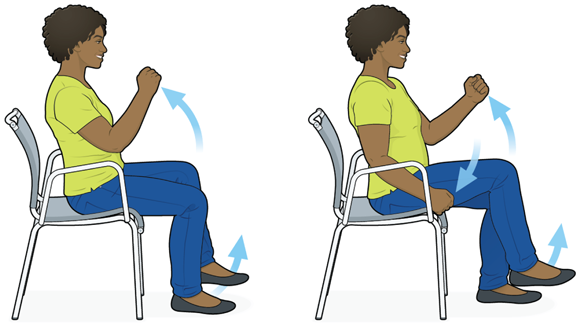
Illustration provided by the American Diabetes Association and David Priess.
FIGURE 10-1: Seated march.
Seated foot drill
This activity is marching to a faster beat, so to speak. Feel free to hold on to the sides of your chair with your hands (as shown in Figure 10-2) while you keep up this faster pace.
- Do the seated march exercise from the preceding section, picking up the pace by tapping your feet faster.
- Continue sitting upright.
- Keep tapping for 45 seconds.
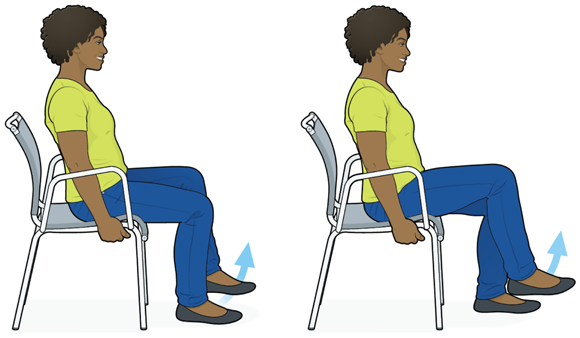
Illustration provided by the American Diabetes Association and David Priess.
FIGURE 10-2: Seated foot drill.
Seated arm curls
This activity (Figure 10-3) rests your legs and gives your arms a workout. You’ll find you can easily do this anytime and anywhere.
- Keeping your elbows at your sides, start with your fists beside your legs.
- Move your fists in front of your body and up toward your shoulders.
- Make sure your elbows stay firmly planted at your sides and bring your fists back down to your legs.
- Repeat the arm curls for 30 seconds (about 30 arm curls).
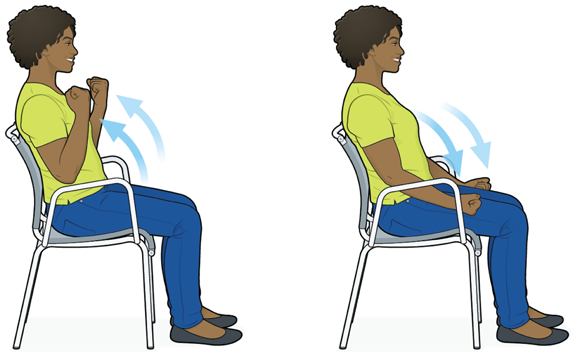
Illustration provided by the American Diabetes Association and David Priess.
FIGURE 10-3: Seated arm curls.
Seated overhead punches
These overhead punches will not only give your shoulders a workout, but they’ll also let you vent your frustrations in a healthy way. Follow Figure 10-4 to get started.
- Start with your fists in front of your shoulders.
- Punch your right fist up overhead and bring it back down.
- Punch your left fist up overhead and bring it down.
- Alternate right-side and left-side punches for 45 seconds (about 20 times for each arm).
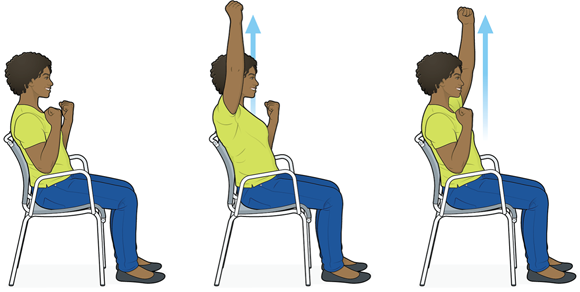
Illustration provided by the American Diabetes Association and David Priess.
FIGURE 10-4: Seated overhead punches.
Standing march
Doing your marching standing will expend even more calories than doing it sitting. So try it (as shown in Figure 10-5) for 45 seconds either as the next step up from doing the seated march (Figure 10-1) or as an additional activity.
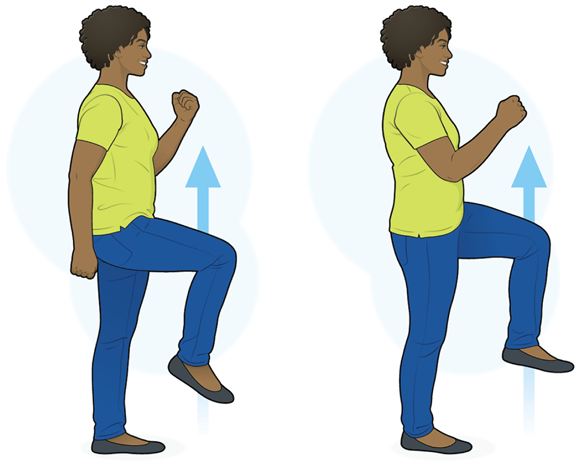
Illustration provided by the American Diabetes Association and David Priess.
FIGURE 10-5: Standing march.
Standing raise the roof
Raising the roof (Figure 10-6) feels like more than double the workout of doing the standing march (shown in Figure 10-5), but it can be so good for raising your heart rate and your fitness level faster. Try it today and practice it as often as you can.
Marching in place, bend your elbows and push both your hands toward the ceiling.
Your palms should be up while you straighten your elbows.
- Bring your hands back to shoulder level and then push them back up toward the ceiling.
- Repeat Steps 1 and 2 for about 45 seconds.
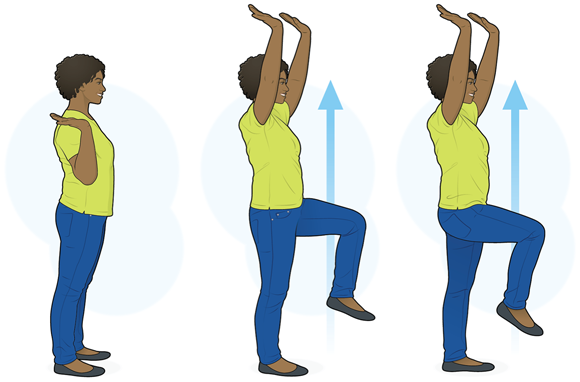
Illustration provided by the American Diabetes Association and David Priess.
FIGURE 10-6: Standing raise the roof.
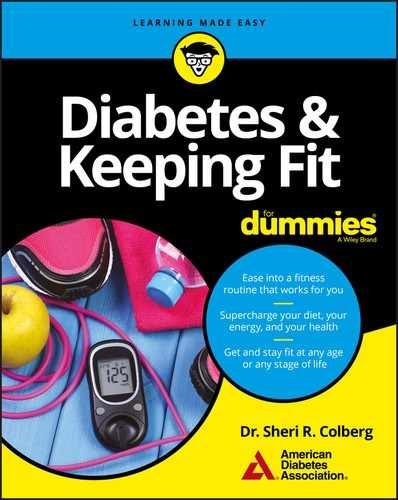
 The bottom line is that you need to include some type of cardio training to stay fit, even if it just consists of walking daily or taking more steps.
The bottom line is that you need to include some type of cardio training to stay fit, even if it just consists of walking daily or taking more steps. Doing any type of aerobic activity has the potential to get you more fit. The key is to pick activities that you can do safely to improve your endurance. Try to include a wide range of activities to increase your overall fitness. As you become more successful and confident at being active, you can add in or substitute other types of activities to expand your exercise options.
Doing any type of aerobic activity has the potential to get you more fit. The key is to pick activities that you can do safely to improve your endurance. Try to include a wide range of activities to increase your overall fitness. As you become more successful and confident at being active, you can add in or substitute other types of activities to expand your exercise options. If you haven’t had your annual checkup this year, getting one prior to starting harder exercise than you’re currently doing may be a good idea. At the same time, your doctor can check for any possible health issues that make being active less safe or less effective and help you manage those. The goal is to be as active as you can possibly be without getting injured or demotivated.
If you haven’t had your annual checkup this year, getting one prior to starting harder exercise than you’re currently doing may be a good idea. At the same time, your doctor can check for any possible health issues that make being active less safe or less effective and help you manage those. The goal is to be as active as you can possibly be without getting injured or demotivated.